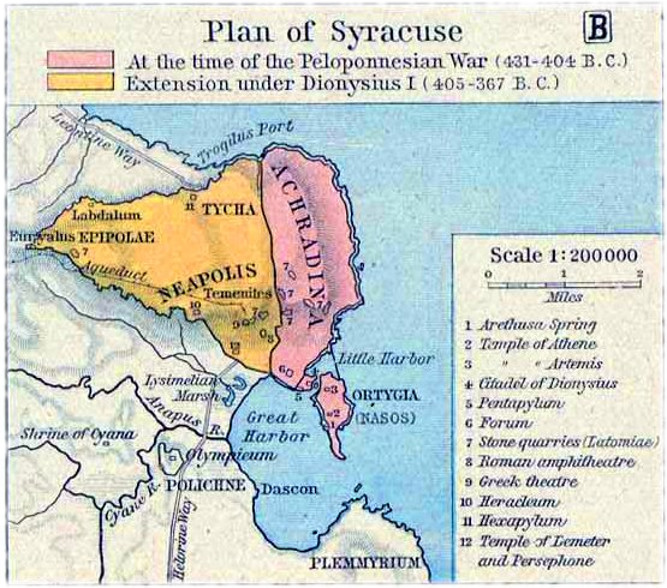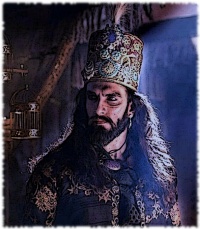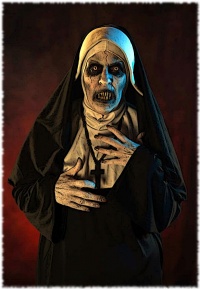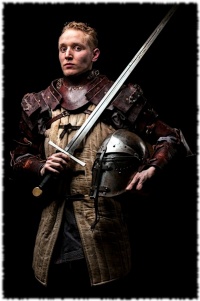Syracuse -- medieval: Difference between revisions
| Line 80: | Line 80: | ||
=== Imperial Roman and Byzantine period === | === Imperial Roman and Byzantine period === | ||
[[]] | |||
<br> | |||
<br> | |||
Though declining slowly through the years, Syracuse maintained the status of capital of the Roman government of Sicily and seat of the praetor. It remained an important port for trade between the Eastern and the Western parts of the Empire. Christianity spread in the city through the efforts of Paul of Tarsus and Saint Marziano, the first bishop of the city, who made it one of the main centres of proselytism in the West. | Though declining slowly through the years, Syracuse maintained the status of capital of the Roman government of Sicily and seat of the praetor. It remained an important port for trade between the Eastern and the Western parts of the Empire. Christianity spread in the city through the efforts of Paul of Tarsus and Saint Marziano, the first bishop of the city, who made it one of the main centres of proselytism in the West. | ||
Revision as of 05:44, 19 March 2019
[[]]
Quote
Appearance
[[]]
Climate
Economy
[[]]
Pilgrimage
Geography
Districts
- Isola di Ortigia
- Acropolis of Syracuse -- fortified citadel
- Giudecca of Syracuse -- Jewish ghetto
- Acradina - Northern district (Muslim)
- Grottasanta - North Eastern district (Byzantine)
- Santa Lucia - Eastern district (Norman)
- Neapolis - North-western district (old Roman)
History
Greek Period

Syracuse and its surrounding area have been inhabited since ancient times, as shown by the findings in the villages of Stentinello, Ognina, Plemmirio, Matrensa, Cozzo Pantano and Thapsos, which already had a relationship with Mycenaean Greece.
Syracuse was founded in 734 or 733 BC by Greek settlers from Corinth and Tenea, led by the oecist (colonizer) Archias. There are many attested variants of the name of the city including Συράκουσαι Syrakousai, Συράκοσαι Syrakosai and Συρακώ Syrakō. A possible origin of the city's name was given by Vibius Sequester citing first Stephanus Byzantius in that there was a Syracusian marsh (λίμνη) called Syrako and secondly Marcian's Periegesis wherein Archias gave the city the name of a nearby marsh; hence one gets Syrako (and thereby Syrakousai and other variants) for the name of Syracuse, a name also attested by Epicharmus. The settlement of Syracuse was a planned event, as a strong central leader, Arkhias the aristocrat, laid out how property would be divided up for the settlers, as well as plans for how the streets of the settlement should be arranged, and how wide they should be. The nucleus of the ancient city was the small island of Ortygia. The settlers found the land fertile and the native tribes to be reasonably well-disposed to their presence. The city grew and prospered, and for some time stood as the most powerful Greek city anywhere in the Mediterranean. Colonies were founded at Akrai (664 BC), Kasmenai (643 BC), Akrillai (7th century BC), Helorus (7th century BC) and Kamarina (598 BC).
The descendants of the first colonists, called Gamoroi, held power until they were expelled by the Killichiroi, the lower class of the city. The former, however, returned to power in 485 BC, thanks to the help of Gelo, ruler of Gela. Gelo himself became the despot of the city, and moved many inhabitants of Gela, Kamarina and Megara to Syracuse, building the new quarters of Tyche and Neapolis outside the walls. His program of new constructions included a new theatre, designed by Damocopos, which gave the city a flourishing cultural life: this in turn attracted personalities as Aeschylus, Ario of Methymna and Eumelos of Corinth. The enlarged power of Syracuse made unavoidable the clash against the Carthaginians, who ruled western Sicily. In the Battle of Himera, Gelo, who had allied with Theron of Agrigento, decisively defeated the African force led by Hamilcar. A temple dedicated to Athena (on the site of today's Cathedral), was erected in the city to commemorate the event.
Syracuse grew considerably during this time. Its walls encircled 120 hectares (300 acres) in the fifth century, but as early as the 470's BC the inhabitants started building outside the walls. The complete population of its territory approximately numbered 250,000 in 415 BC and the population size of the city itself was probably similar to Athens.
Gelo was succeeded by his brother Hiero, who fought against the Etruscans at Cumae in 474 BC. His rule was eulogized by poets like Simonides of Ceos, Bacchylides and Pindar, who visited his court. A democratic regime was introduced by Thrasybulos (467 BC). The city continued to expand in Sicily, fighting against the rebellious Siculi, and on the Tyrrhenian Sea, making expeditions up to Corsica and Elba. In the late 5th century BC, Syracuse found itself at war with Athens, which sought more resources to fight the Peloponnesian War. The Syracusans enlisted the aid of a general from Sparta, Athens' foe in the war, to defeat the Athenians, destroy their ships, and leave them to starve on the island (see Sicilian Expedition). In 401 BC, Syracuse contributed a force of 300 hoplites and a general to Cyrus the Younger's Army of the Ten Thousand.
Then in the early 4th century BC, the tyrant Dionysius the Elder was again at war against Carthage and, although losing Gela and Camarina, kept that power from capturing the whole of Sicily. After the end of the conflict Dionysius built a massive fortress on Ortygia and 22 km-long walls around all of Syracuse. Another period of expansion saw the destruction of Naxos, Catania and Lentini; then Syracuse entered again in war against Carthage (397 BC). After various changes of fortune, the Carthaginians managed to besiege Syracuse itself, but were eventually pushed back by a pestilence. A treaty in 392 BC allowed Syracuse to enlarge further its possessions, founding the cities of Adranon, Tyndarion and Tauromenos, and conquering Rhegion on the continent. In the Adriatic, to facilitate trade, Dionysius the Elder founded Ancona, Adria and Issa. Apart from his battle deeds, Dionysius was famous as a patron of art, and Plato himself visited Syracuse several times.
His successor was Dionysius the Younger, who was however expelled by Dion in 356 BC. But the latter's despotic rule led in turn to his expulsion, and Dionysius reclaimed his throne in 347 BC. Dionysius was besieged in Syracuse by the Syracusan general Hicetas in 344 BC. The following year the Corinthian Timoleon installed a democratic regime in the city after he exiled Dionysius and defeated Hicetas. The long series of internal struggles had weakened Syracuse's power on the island, and Timoleon tried to remedy this, defeating the Carthaginians in the Battle of the Crimissus (339 BC).
After Timoleon's death the struggle among the city's parties restarted and ended with the rise of another tyrant, Agathocles, who seized power with a coup in 317 BC. He resumed the war against Carthage, with alternate fortunes. He was besieged in Syracuse by the Carthaginians in 311 BC, but he escaped from the city with a small fleet. He scored a moral success, bringing the war to the Carthaginians' native African soil, inflicting heavy losses to the enemy. The defenders of Syracuse destroyed the Carthaginian army which besieged them. However, Agathocles was eventually defeated in Africa as well. The war ended with another treaty of peace which did not prevent the Carthaginians from interfering in the politics of Syracuse after the death of Agathocles (289 BC). They laid siege to Syracuse for the fourth and last time in 278 BC. They retreated at the arrival of king Pyrrhus of Epirus, whom Syracuse had asked for help. After a brief period under the rule of Epirus, Hiero II seized power in 275 BC.
Hiero inaugurated a period of 50 years of peace and prosperity, in which Syracuse became one of the most renowned capitals of Antiquity. He issued the so-called Lex Hieronica, which was later adopted by the Romans for their administration of Sicily; he also had the theatre enlarged and a new immense altar, the "Hiero's Ara", built. Under his rule lived the most famous Syracusan, the mathematician and natural philosopher Archimedes. Among his many inventions were various military engines including the claw of Archimedes, later used to resist the Roman siege of 214 BC–212 BC. Literary figures included Theocritus and others.
Hiero's successor, the young Hieronymus (ruled from 215 BC), broke the alliance with the Romans after their defeat at the Battle of Cannae and accepted Carthage's support. The Romans, led by consul Marcus Claudius Marcellus, besieged the city in 214 BC. The city held out for three years, but fell in 212 BC. The successes of the Syracusians in repelling the Roman siege had made them overconfident. In 212 BC, the Romans received information that the city's inhabitants were to participate in the annual festival to their goddess Artemis. A small party of Roman soldiers approached the city under the cover of night and managed to scale the walls to get into the outer city and with reinforcements soon took control, killing Archimedes in the process, but the main fortress remained firm. After an eight-month siege and with parleys in progress, an Iberian captain named Moeriscus is believed to have let the Romans in near the Fountains of Arethusa. On the agreed signal, during a diversionary attack, he opened the gate. After setting guards on the houses of the pro-Roman faction, Marcellus gave Syracuse to plunder.
Imperial Roman and Byzantine period
[[]]
Though declining slowly through the years, Syracuse maintained the status of capital of the Roman government of Sicily and seat of the praetor. It remained an important port for trade between the Eastern and the Western parts of the Empire. Christianity spread in the city through the efforts of Paul of Tarsus and Saint Marziano, the first bishop of the city, who made it one of the main centres of proselytism in the West.
In the age of Christian persecutions massive catacombs were carved, whose size is second only to those of Rome.
After a period of Vandal rule, Syracuse and the island was recovered by Belisarius for the Byzantine Empire (31 December 535). From 663 to 668 Syracuse was the seat of Emperor Constans II, as well as a capital of the Roman Empire and metropolis of the whole Sicilian Church.
Emirate of Syracuse
The city was besieged by the Aghlabids for almost a year in 827–828, but Byzantine reinforcements prevented its fall. It remained the center of Byzantine resistance to the gradual Muslim conquest of Sicily until it fell to the Aghlabids after another siege on 20/21 May 878. During the two centuries of Muslim rule, the capital of the Emirate of Sicily was moved from Syracuse to Palermo. The Cathedral was converted into a mosque and the quarter on the Ortygia island was gradually rebuilt along Islamic styles. The city, nevertheless, maintained important trade relationships, and housed a relatively flourishing cultural and artistic life: several Arab poets, including Ibn Hamdis, the most important Sicilian Arab poet of the 12th century, flourished in the city.
In 1038, the Byzantine general George Maniakes reconquered the city, sending the relics of St. Lucy to Constantinople. The eponymous castle on the cape of Ortygia bears his name, although it was built under the Hohenstaufen rule. In 1085 the Normans entered Syracuse, one of the last Arab strongholds, after a summer-long siege by Roger I of Sicily and his son Jordan of Hauteville, who was given the city as count. New quarters were built, and the cathedral was restored, as well as other churches.
1086 A.D. -- The Normans take the City
Count Roger left Sicily in the summer of 1083 to assist his brother on the mainland; Jordan (whom he had left in charge) revolted, forcing him to return to Sicily and subjugate his son. In 1085, he was finally able to undertake a systematic campaign. On 22 May Roger approached Syracuse by sea, while Jordan led a small cavalry detachment 15 miles (24 km) north of the city. On 25 May, the navies of the count and the emir engaged in the harbor — where the latter was killed — while Jordan's forces besieged the city. The siege lasted throughout the summer, but when the city capitulated in March 1086 only Noto was still under Saracen dominion. In February 1091 Noto yielded as well, and the conquest of Sicily was complete.
Timeline
Current Events
Politics
Population
- Likely Population, 1100 A.D. ????
Citizens of Bremen
Clergy
- [[]] --
- [[]] --
- [[]] --
- [[]] --
Source
http://www.fantasynamegenerators.com/frankish-names.php
Craftsmen
Criminals
Crusaders
Patriciate
- Turalt Auber -- Baron de Hauteville (cousin of Count Rodger)
Students
Festivities
- Twelfth Night (January) -- Religious festival and feasts celebrating the visit of the Wise Men, or Magi, following the birth of Jesus.
- St Valentine's Day (February) -- The Medieval festival celebrating love - singing, dancing and pairing games.
- Carnival (Late February - Early March) --
- Easter (March) -- Easter celebrated by the Mystery plays depicting the crucifixion.
- Lent (40 days)
- Ash Wednesday (start of Lent)
- Holy Week (last week of Lent before Easter)
- Good Friday (end of Lent)
- Easter Sunday
- All Fool's Day (April) -- The Jesters, or Lords of Misrule, took charge for the day and caused mayhem with jokes and jests!
- May Day (May) -- May Day was a spring festival celebrating May Day when a Queen of the May was chosen and villagers danced around the maypole.
- Midsummer Eve (June) -- Midsummer Eve, the Mummers entertained at the 'Festival of Fire' reliving legends such as St George and the Dragon. Bones were often burned leading to the term 'bonfire'. The summer Solstice was June 23rd.
- St. Swithin's Day (July) -- St. Swithin's Day falls on 15th July. Legend says that during the bones of St Swithin were moved and after the ceremony it began to rain and continued to do so for forty days.
- Lammas Day (August) -- Lammas Day was celebrated on August 2nd. The ' loaf-mass ' day, the festival of the first wheat harvest of the year. Houses were sometimes decorated with garlands and there were candle lit processions.
- Michaelmas (September) -- The 29th September was when Michaelmas celebrated the life of St Michael and the traditional food on Michaelmas was goose or chicken.
- St Crispin's Day (October) -- October 25th celebrating St Crispin's Day. Revels and bonfires and people acted as 'King Crispin' .
- All Souls Day (November) -- The Day of the Dead - All Souls Day or All Hallow's Day ( Halloween ) when revels were held and bonfires were lit.
- Christmas (December) -- December 25 is celebrated as the birthday of Christ.
Fortifications
The Walls of Syracuse
Inns
Source
https://donjon.bin.sh/fantasy/inn/
Law & Lawlessness
Monuments
Amphitheaters
Aqueducts
Arches (Triumphal)
Baths
Bridges
Catacombs of
- [[]] --
Cemeteries
- Grotticelli Nechropolis --
- Necropolis of Pantalica --
- [[]] --
Columns
- [[]]
- [[]]
Fountains
Gardens
Statues
Temples
Tombs
Hospitals
Markets
Private Residences
- [[]] --
- [[]] --
Taverns
Religion
Roman Catholic Syracuse
Churches
Convents
Monasteries
Cults
- Cult of Apollo
- Followers of Nyx
- House of the Erinyes
- Servitors of the Witch-Queen
- Temple of Venus Callipyge
Visitors
Whore Houses
Vampires of Syracuse
Assamites
 -- Navid Amjad -- Leader of the Assamites (Vizier Caste)
-- Navid Amjad -- Leader of the Assamites (Vizier Caste) -- Najm Sharif -- Chief warrior
-- Najm Sharif -- Chief warrior
Followers of Set
 -- Shat -- Leader of Setites in the City and Follower of the Path of the Serpent
-- Shat -- Leader of Setites in the City and Follower of the Path of the Serpent -- Toses -- Setite Sorceress
-- Toses -- Setite Sorceress -- Ameniritis -- Follower of the Path of War
-- Ameniritis -- Follower of the Path of War
Lasombra
 -- Eirini -- Childe of Ahumm, princess of Syracuse {Missing or Possibly deceased}
-- Eirini -- Childe of Ahumm, princess of Syracuse {Missing or Possibly deceased} -- Lady Mortis -- Neonate Childe of Sybil
-- Lady Mortis -- Neonate Childe of Sybil- Anika Riese -- German Ancilla seeking an audience at the Castle of Shadows
Nosferatu
 -- Sotiria Marinos -- Eldest Nosferatu and Christian nun
-- Sotiria Marinos -- Eldest Nosferatu and Christian nun -- Boemund Burce -- Norman French Knight turned beggar king
-- Boemund Burce -- Norman French Knight turned beggar king
Ravnos
 -- Madame Bianca -- Vadoma of the Gypsies
-- Madame Bianca -- Vadoma of the Gypsies
Toreador
 -- Maria Michelakakis -- Elder Toreador and Leader of the Clan of Roses
-- Maria Michelakakis -- Elder Toreador and Leader of the Clan of Roses -- Quentin de La Reue -- Norman French Knight
-- Quentin de La Reue -- Norman French Knight
True Brujah
- [[]] -- Arkhias the Aristocrat -- true Brujah Ancient
- [[]] -- Hiero Arrabbiato -- Italian warrior
Crucesignatis (Crusaders)
- [[]] -- [[]] --
- [[]] -- [[]] --
- [[]] -- [[]] --
- [[]] -- [[]] --
- [[]] -- [[]] --
- [[]] -- [[]] --
Incognitos (Strangers and Aliens)
Memoria pro Mortuis (Remembrances for the Dead)
- [[]] --
- [[]] --
- [[]] --
- [[]] --
Wraiths of medieval Syracuse
- [[]]
- [[]]
Storytelling Medieval Syracuse
Mood of Medieval Syracuse:
Stories of medieval Syracuse
- [[]]
- [[]]
- [[]]
- [[]]
Websites
https://en.wikipedia.org/wiki/Syracuse,_Sicily
